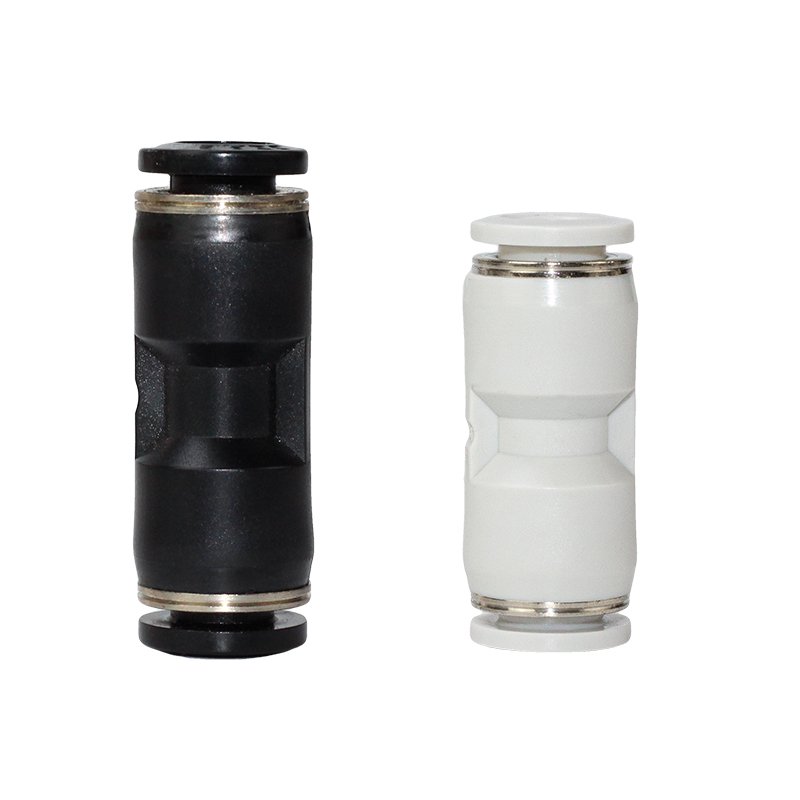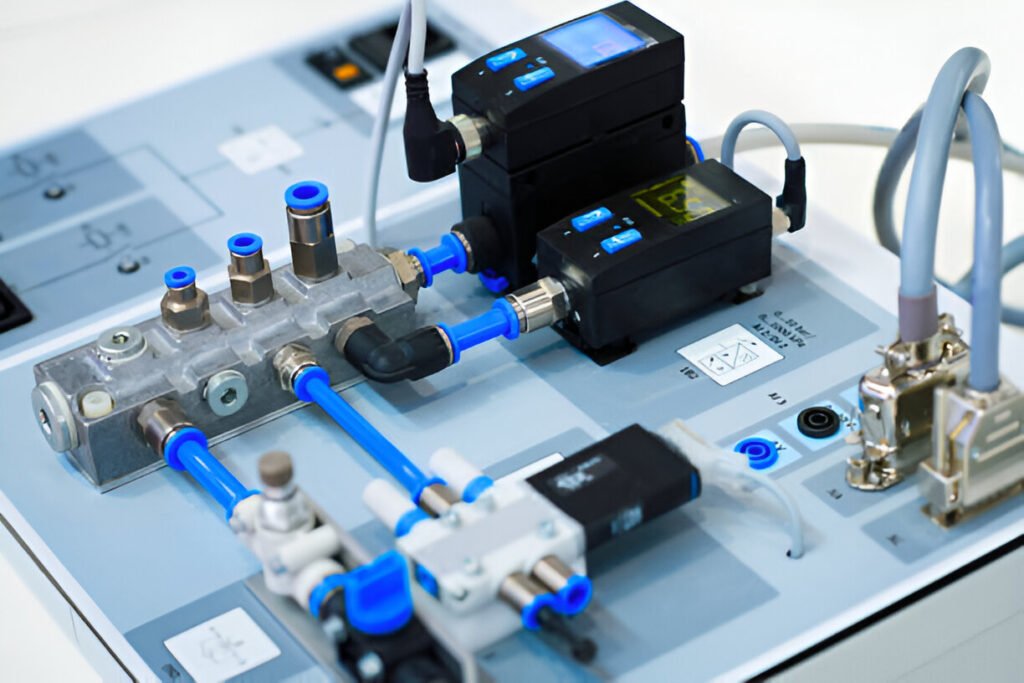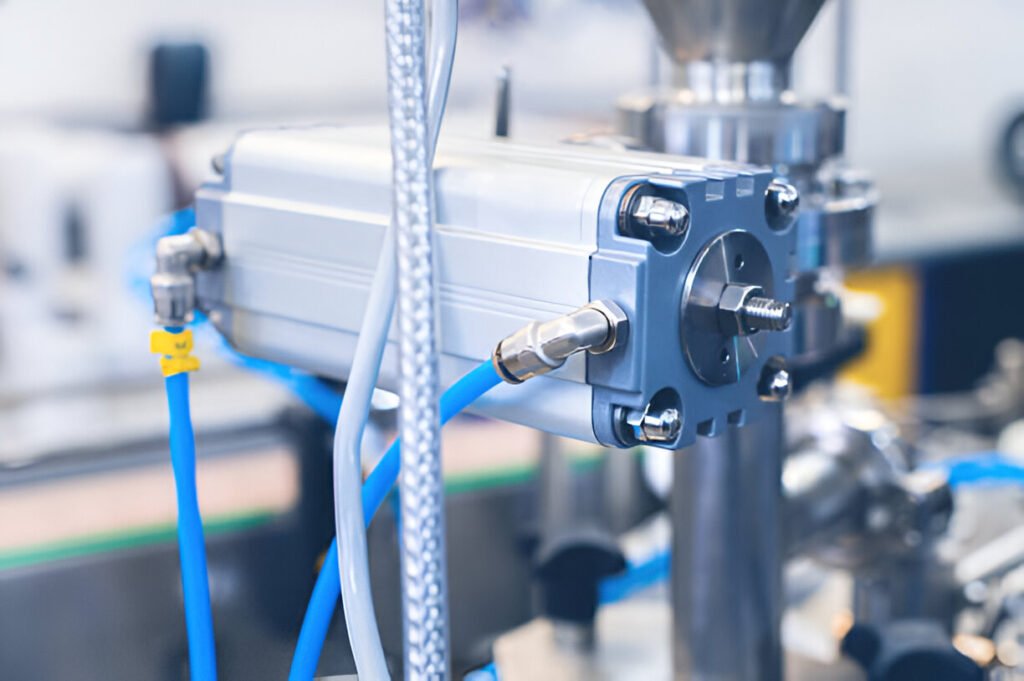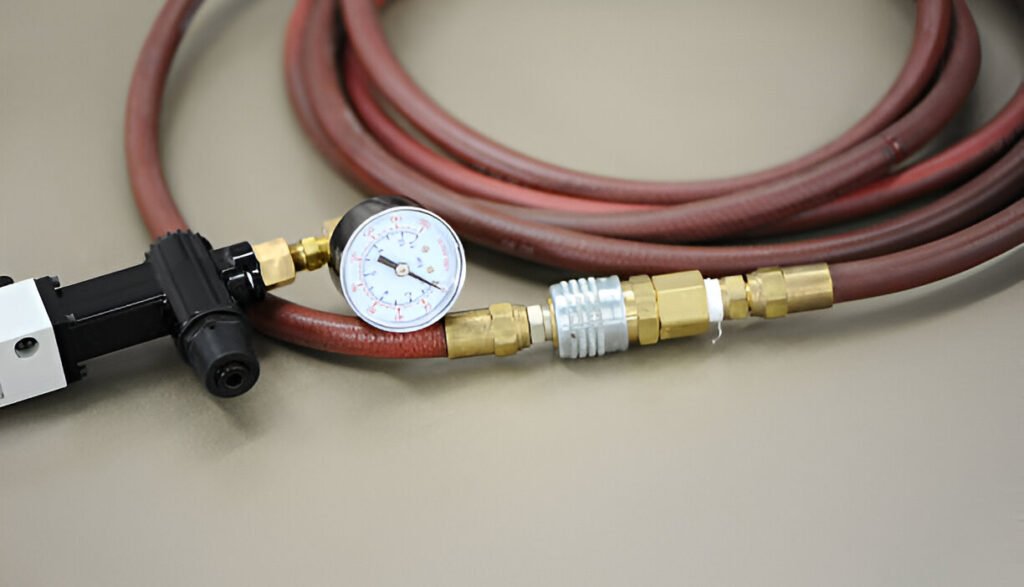The definition and importance of mini cylinders
Mini cylinder, a compact pneumatic actuator, uses compressed air to generate linear motion force and is widely used in automation technology. Its core components include the cylinder block, piston and piston rod. By controlling the amount of compressed air entering the cylinder, the mini cylinder can achieve precise pushing or pulling. Due to its compact size, mini cylinders are particularly suitable for applications where space is limited or equipment miniaturization is required.
In the field of automation, mini cylinders play a vital role. They not only improve production efficiency and operational accuracy, but also enhance system flexibility and reliability. Mini cylinders can be found in a variety of automation devices, such as assembly lines, automated robotic arms, and precision filling systems, performing simple or complex actions such as pushing, rotating, lifting, and positioning.
Its importance lies in:
- Precise control: Mini cylinders can precisely control force, speed and position, which is crucial for improving product quality and production efficiency.
- Improve the level of automation: They are key components to achieve mechanical automation and reduce manual operations, especially in production processes with high precision and repeatability requirements.
- Strong adaptability: Mini cylinders can work in various harsh environments, including high and low temperatures or environments containing corrosive substances.
- Cost-effective: Compared to electric actuators, mini-cylinders offer a more cost-effective and easier-to-maintain solution in many cases.
The basic working principle of mini cylinder and the background of its wide application
The basic working principle of the mini cylinder, in short, is to achieve precise linear motion through the power of compressed air. The process involves the controlled flow of compressed air inside a cylinder, driving a piston inside the cylinder to move back and forth, thereby pushing mechanical components attached to the piston rod to perform various tasks. In the context of the development of automation technology, mini cylinders are widely used because of their efficient and reliable performance.
Basic working principle
The core of the working principle of the mini cylinder lies in the management of compressed air. When compressed air is directed into one side of the cylinder, it pushes against the piston, causing it to move along the cylinder. This action allows the piston to move in both directions by changing the port through which air enters the cylinder, driving the piston rod to perform a pulling or pushing operation. By adjusting the air pressure entering the cylinder, the force, speed and stopping position of the piston can be precisely controlled to achieve complex automation tasks.
Widely used background
As the level of industrial automation continues to improve, the demand for precise control, operational flexibility and system reliability is growing. Mini cylinders are ideal for meeting these needs due to their compact design, outstanding performance and excellent adaptability. From simple material handling to complex assembly operations, mini cylinders find their way into a variety of automation applications. They not only improve production efficiency and reduce labor costs, but also ensure product quality by improving operating accuracy.
In the context of automation, mini cylinders have a wide range of applications, including but not limited to:
- Assembly line: performs product assembly, positioning and inspection.
- Robotics: Powering robotic arms to perform precise operations.
- Packaging Machinery: Performs fast and repetitive packaging tasks.
- Testing equipment: Provides stable testing power during the quality control process.
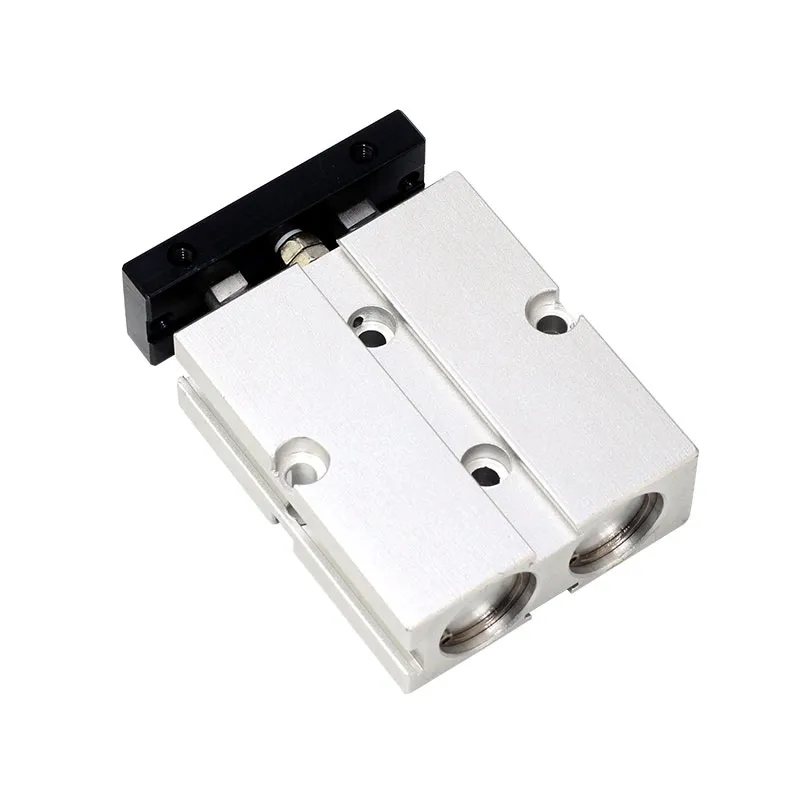
Basic components of mini cylinder
Mini cylinders, as precision pneumatic actuators, are widely used in the field of automation. Understanding its basic components is crucial to fully realizing its functionality. The following is a detailed introduction to the main components and functions of the mini cylinder:
1. Cylinder block
The cylinder block is the shell of a mini cylinder, usually made of high-strength materials such as aluminum alloy or stainless steel, to carry internal mechanical components and create a high-pressure working environment. It not only provides the movement trajectory for the piston, but also ensures the sealing of the compressed air. It is the most basic component of the mini cylinder.
2. Piston
The piston is located inside the cylinder block and is the core of the cylinder’s power output. It can move back and forth along the axis of the cylinder block and transmit power to the mechanical system through the piston rod. One side of the piston receives the thrust of compressed air, while the other side may be reset by a spring or compressed air. The design and material selection of the piston have a direct impact on the performance and life of the cylinder.
3. Piston rod
The piston rod is the bridge connecting the piston and the external load. It extends from one end of the cylinder block and is directly connected to the executing mechanical components. The diameter, material and surface treatment of the piston rod need to be carefully considered in the design because they directly affect the load-bearing capacity and durability of the cylinder.
4. End cap
The end caps are located at both ends of the cylinder block to close the cylinder block and maintain its internal sealing state. The end cap is usually equipped with air inlets and exhaust ports to control the inflow and discharge of compressed air. In some designs, the end cover may also integrate a buffer device or positioning sensor to improve the control accuracy and safety of the cylinder.
5. Seals
Seals play a vital role in mini cylinders. They ensure the airtightness of the cylinder under high-pressure working conditions and prevent the leakage of compressed air. These seals include piston seals, rod seals, end cap seals, etc. They are usually made of wear-resistant and high-pressure-resistant materials, such as polyurethane or fluoroelastomer.
6. Accessories and control elements
To suit different application needs, mini cylinders may be equipped with a variety of accessories and control elements, such as:
- Positioning sensor: used to detect the position of the cylinder piston and provide precise position feedback.
- Buffer device: installed at both ends of the cylinder to absorb the impact force when the piston reaches the end of the stroke and protect the cylinder and load from damage.
- Flow control valve: regulates the movement speed of the cylinder piston to achieve smooth and precise speed control.
How the mini cylinder works
The working principle of the mini cylinder is based on the power of compressed air to drive the piston to make linear reciprocating motion in the cylinder, thereby converting it into mechanical energy to perform various work tasks. Here is a detailed explanation of how the mini cylinder works:
1. Introduction and discharge of compressed air
The movement of the mini cylinder is achieved by controlling the entry and exit of compressed air inside the cylinder. There are usually air inlets and exhaust ports at both ends of the cylinder, and directional control valves are used to control the flow of air. When compressed air enters the cylinder from one end, it pushes the piston toward the other end. At the same time, the air at the other end is exhausted to the atmosphere or a recovery system.
2. Reciprocating motion of the piston
The piston is a key component inside the mini cylinder. It fits closely with the inner wall of the cylinder to ensure that air does not leak from between the two. When compressed air pushes the piston to move, the piston rod also moves, converting pneumatic energy into mechanical energy. By changing the state of the control valve, compressed air can enter from the other end of the cylinder, pushing the piston back to its original position, completing a reciprocating cycle.
3. Force output
The piston rod is connected to the piston and extends outside the cylinder, converting the reciprocating motion of the piston into linear motion of an external load. This linear motion can be used to push, pull or position workpieces, such as moving parts on automated assembly lines or positioning them in machining.
4. Speed and power control
The speed and output power of the mini cylinder can be controlled by adjusting the pressure and flow of compressed air entering the cylinder. The flow rate of the gas can be precisely adjusted using a flow control valve, thereby controlling the moving speed of the piston. At the same time, the pressure of the compressed air determines the force of the piston to push the load. This enables the mini cylinder to achieve highly precise control under different operating conditions.
5. Single-acting and double-acting cylinders
Mini cylinders can be single or double acting. Single-acting cylinders use compressed air to drive a piston in only one direction, usually with a spring or gravity to achieve reverse motion. Double-acting cylinders, on the other hand, use compressed air in both directions, providing greater power and control flexibility.
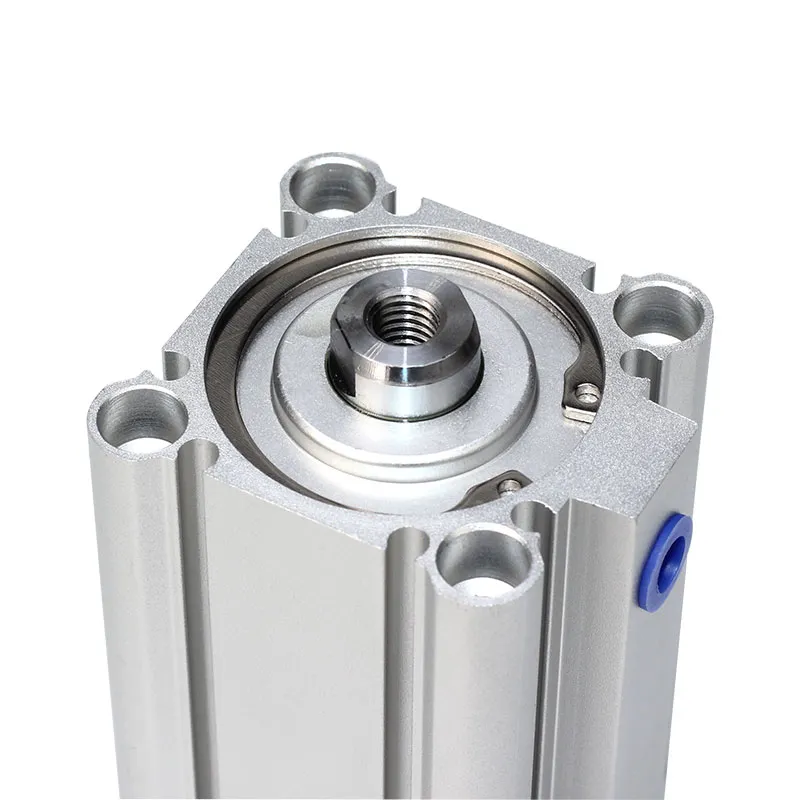
Mini cylinder control system
The mini cylinder’s control system is key to its efficient and precise operation, involving fine management of compressed air flow and direction. This system usually consists of multiple components, including directional control valves, speed controls, sensors, etc., which work together to achieve precise control of the mini-cylinder’s action.
1. Directional control valve
The directional control valve is the core of the control system, used to control the path of compressed air entering the cylinder, thereby determining the direction of movement of the piston. These valves can be manually operated, solenoid actuated, or pneumatically controlled, allowing the operator to change the direction of air flow as desired.
- 2/2 valve: has two interfaces (inlet and outlet) and two positions (on/off), suitable for simple control of single-acting cylinders.
- 3/2 valve: For single-acting cylinders, it provides three interfaces (an air inlet, a working port and an exhaust port) and two positions, which can control the extension or retraction of the cylinder.
- 4/2 valve and 5/2 valve: suitable for double-acting cylinders, providing four or five interfaces and two positions, capable of controlling the bidirectional movement of the cylinder piston.
2. Speed control device
A speed control device (usually a throttle or flow control valve) regulates the flow of air into and out of the cylinder, thereby controlling how fast the piston moves. These devices can be mounted individually on the intake or exhaust port of the cylinder, or integrated into the directional control valve.
- Throttle Valve: Slows down airflow by limiting the amount of air flowing through the valve.
- Flow control valve: regulates air flow more precisely, often with a reverse flow lock function to ensure stable speed control.
3. Sensor and feedback system
In order to achieve more precise control, mini cylinder systems often include position sensors and pressure sensors, which provide real-time feedback information for monitoring and adjusting the status of the cylinder.
- Position sensor: such as proximity switch, magnetic sensor, etc., used to detect the position of the piston to ensure that the piston can stop at the correct position.
- Pressure Sensor: Monitors pressure changes in the system to optimize performance and protect equipment from overpressure damage.
4. Control logic and interface
The control system of the mini cylinder also includes the necessary control logic and human-machine interface (HMI), which can be implemented through a PLC (programmable logic controller), computer system or manual control panel. These control logics are responsible for integrating sensor inputs, user commands and preset parameters to automatically or semi-automatically control the operation of the cylinder.
Types and applications of mini cylinders
There are various types of mini cylinders, and depending on their design and functionality, they can meet the needs of various automation and machine designs. Here are some of the main types of mini cylinders and their typical applications:
| Types | Features | Application |
|---|---|---|
| Single-acting cylinder | Utilizes compressed air to move the piston in one direction, with a spring or gravity returning it to the initial position. | Commonly used in simple action scenarios, such as automatic door controls, clamping devices in small assembly machinery, etc. |
| Double-acting cylinder | Uses compressed air to drive the piston in both directions, offering greater force output and flexibility. | Widely used in automation production lines, robotic arms, precision positioning devices, especially where bidirectional control and high force output are needed. |
| Rodless cylinder | Lacks a traditional piston rod, using an internal mechanical or magnetic coupling mechanism to achieve linear motion, allowing for a longer stroke. | Suitable for applications requiring long strokes or where space is limited, such as conveyor systems, large mechanical equipment movement parts, etc. |
| Guided cylinder | Features additional guiding devices capable of withstanding lateral loads, ensuring piston rod stability. | Used in applications requiring high-precision guidance or where significant lateral forces are present on the piston rod, such as in automation assembly, high-precision positioning, etc. |
| Compact cylinder | Designed with a small size to fit in limited spaces. | Ideal for limited-space automation equipment, small machinery, and precision instruments. |
| Rotary cylinder | Converts compressed air’s linear motion into rotational movement. | Employed in situations requiring rotational actions, such as adjusting valves, rotating worktables, etc. |
Applications
- Automated production line: Double-acting cylinders are used to push, position and clamp materials.
- Robotic arms: Use rodless and guided cylinders to achieve precise control and long-distance movement.
- Packaging Machinery: Compact cylinders are used for quick clamping and release operations in small packaging equipment.
- Text processing equipment: Single-acting cylinders are used to achieve simple opening, closing and pushing actions.

Mini cylinder selection guide
Choosing the right mini cylinder for your application involves considering several critical factors to ensure optimal performance and reliability. Here is a detailed selection guide:
1. Determine the Type of Cylinder
- Single-Acting Cylinders: Best for applications requiring simple movement in one direction with a spring return. Ideal for low-power, space-saving solutions.
- Double-Acting Cylinders: Suitable for applications needing controlled movement in both directions. They offer more force and control flexibility.
- Rodless Cylinders: Opt for these when you require a long stroke in a compact space.
- Rotary Cylinders: When rotational movement is needed, rotary cylinders are the go-to option.
- Guided Cylinders: Necessary when the load has side forces that could cause bending or misalignment.
2. Calculate the Required Force
Determine the force needed for your application by considering the load, friction, and any external forces. Ensure the selected cylinder can provide force that exceeds this calculated value.
3. Choose the Appropriate Bore Size
The bore size directly impacts the force a cylinder can exert. Larger bore sizes offer more force but consume more air and take up more space. Select a bore size that meets your force requirements efficiently.
4. Determine the Stroke Length
The stroke length is the distance the piston travels. Choose a cylinder whose stroke length matches your application’s movement requirements, considering any space constraints.
5. Select the Appropriate Mounting Style
The mounting style affects the stability and alignment of the cylinder. Common mounting options include flange, foot, clevis, and trunnion. Consider the application’s mechanical layout and motion requirements.
6. Consider the Operating Environment
- For harsh environments, consider cylinders made from corrosion-resistant materials like stainless steel.
- For cleanroom or food processing applications, look for cylinders designed to meet hygienic standards.
7. Evaluate Speed Requirements
The cylinder speed is influenced by air flow and pressure. Use flow control valves to adjust speed as needed. Ensure the cylinder can operate at your desired speed without sacrificing performance or longevity.
8. Assess Port Size and Air Supply
Ensure the cylinder’s port size is compatible with your air supply lines and that your air supply can accommodate the cylinder’s air consumption, especially for large bore sizes or high-speed applications.
9. Check Compatibility with Sensors and Accessories
If your application requires position sensing, choose cylinders compatible with magnetic sensors or have built-in sensor slots. Also, consider any additional accessories needed, such as rod end attachments or brackets.
10. Review Manufacturer Specifications and Support
Select a cylinder from a reputable manufacturer that provides detailed specifications and good customer support. Availability of replacement parts and technical assistance can be crucial for maintenance and troubleshooting.
Maintenance and troubleshooting
Regular maintenance
- Cleaning: Clean the outside of the cylinder regularly to prevent the accumulation of dust and contaminants that may enter the interior of the cylinder and cause increased wear.
- Check the seals: Worn or damaged seals are a common cause of cylinder leaks. Check the condition of seals regularly and replace worn or damaged seals promptly.
- Lubrication: Ensure piston rods and other moving parts are properly lubricated to reduce wear. Use a lubricant appropriate for your cylinder material.
- Check fasteners: Check all connections and fasteners regularly to ensure that the cylinder and its mounting structure are stable and not loose.
troubleshooting
1. The cylinder does not move:
- Check whether the air source is turned on and whether the air pressure meets the cylinder working requirements.
- Check whether the solenoid valve receives the control signal and whether the solenoid valve is working properly.
- Check whether the cylinder is stuck or subject to excessive external load resistance.
2. The cylinder moves slowly:
- Check whether the air supply pressure is sufficient.
- Check the pipes for leaks, especially joints and seals.
- Check for excessive friction or unlubricated parts.
3. Cylinder leakage:
- Locate the leak point (cylinder head seal, piston seal or pipe connection).
- Replace damaged seals or tighten loose pipe connections.
4. Cylinder output force decreases:
- Check whether the air source pressure is unstable or too low.
- Check for internal leaks, possibly caused by worn seals.
- Make sure there is no abnormal wear on the piston rod and guide to ensure smooth movement.
Common precautions
- Use an air source and lubricant that matches the cylinder specifications and working environment.
- Avoid operating the cylinder under conditions beyond design specifications, such as exceeding recommended pressure, temperature or load.
- Keep the air source clean to avoid moisture and oil entering the cylinder, which may cause internal corrosion and reduced performance.

Summarize
Maintenance and effective troubleshooting of mini cylinders are key to ensuring their long-term stable operation. Many common problems can be prevented by implementing regular maintenance measures such as cleaning, checking seals, proper lubrication, and inspecting fasteners. When encountering a fault, systematically checking the air source, solenoid valve, pipeline leakage and seal condition is an effective way to quickly diagnose and solve the problem. At the same time, understanding the working principle and components of the cylinder can help with better troubleshooting.
It is important to remember that selecting the appropriate cylinder type, ensuring a clean air supply, and avoiding operating the cylinder outside of its design specifications are all key factors in maintaining cylinder performance and extending service life. By following these maintenance and troubleshooting guidelines, mini cylinder reliability can be significantly improved, unplanned downtime reduced, and the automation system running efficiently.




